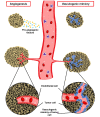Angiogenesis and vasculogenic mimicry as therapeutic targets in ovarian cancer
- PMID: 32438972
- PMCID: PMC7330806
- DOI: 10.5483/BMBRep.2020.53.6.060
Angiogenesis and vasculogenic mimicry as therapeutic targets in ovarian cancer
Abstract
Tumor angiogenesis is an essential process for growth and metastasis of cancer cells as it supplies tumors with oxygen and nutrients. During tumor angiogenesis, many pro-angiogenic factors are secreted by tumor cells to induce their own vascularization via activation of pre-existing host endothelium. However, accumulating evidence suggests that vasculogenic mimicry (VM) is a key alternative mechanism for tumor vascularization when tumors are faced with insufficient supply of oxygen and nutrients. VM is a tumor vascularization mechanism in which tumors create a blood supply system, in contrast to tumor angiogenesis mechanisms that depend on pre-existing host endothelium. VM is closely associated with tumor progression and poor prognosis in many cancers. Therefore, inhibition of VM may be a promising therapeutic strategy and may overcome the limitations of anti-angiogenesis therapy for cancer patients. In this review, we provide an overview of the current anti-angiogenic therapies for ovarian cancer and the current state of knowledge regarding the links between microRNAs and the VM process, with a focus on the mechanism that regulates associated signaling pathways in ovarian cancer. Moreover, we discuss the potential for VM as a therapeutic strategy against ovarian cancer. [BMB Reports 2020; 53(6): 291-298].
Conflict of interest statement
The authors have no conflicting interests.
Figures



